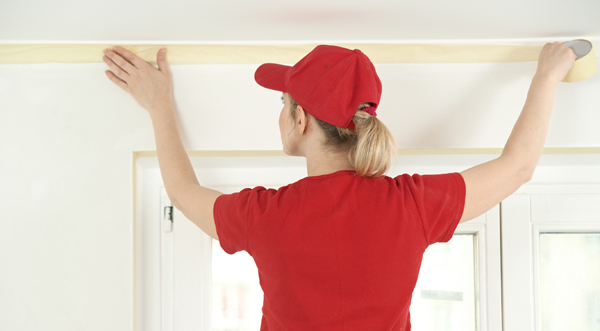Should you tackle that painting job yourself or hire a professional?
Here are points to consider
By Tammy Adamson-McMullen
Like many consumers, you might have toyed with the idea of tackling a painting project yourself—maybe to save the costs of hiring a professional painter. But before you reach a final decision, there are important points to consider. And not all of them involve money.
Abilities
First, it’s important to be honest with yourself: Do you have what it takes to produce a satisfactory end result? If you answer “yes” to most of the answers below, then a DIY painting project might be in your future. If not, it’s probably time to call a professional.
· Patience: Patience—or endurance—is one of the most important skills in painting. Do you have the patience to plan the project from start to finish? To prepare the surface to be painted, such as washing walls, filling nail holes and gauges, sanding uneven surfaces, masking abutting walls and trim, and priming? To work slowly and meticulously until the project is complete? To wait for the paint to dry between coats? And to properly clean up your work area and tools?
· Fine Motor Skills: You don’t have to be Van Gogh, but it’s helpful to have a modicum of skills. Can you properly hold and manipulate brushes and rollers? Can you lay painter’s tape in a straight line? Can you “cut in” corners and small areas? Lay on even coats of paint? Avoid major spills and splatters?
· Strength: Painting can be physically demanding, although proper tools definitely help. But it’s worth asking: Do you have the strength to move furniture out of the way? To lay tarps to protect flooring and furniture? To pour paint into trays? Can you carry and climb ladders? And bend over for lengths of time?
Project Scope
Many DIYers have no qualms about painting a small room or focus wall. But what about larger and more complex projects, such as finishing kitchen cabinets or painting a two-story exterior? Before starting any project, do your research to understand its scope—products that are needed and steps involved. Watch YouTube instructional videos that show similar projects, do extra reading on the Internet and discuss the project with your local paint retailer. A paint retailer can help plot the project and can suggest everything you’ll need—which might include renting additional equipment, such as a power sander, pressure washer, paint sprayer or scaffolding.
DIY Budget
There’s no doubt that doing a project yourself saves money (unless you make a mistake that requires a do-over). But don’t go overboard by skimping on paint and tools. Purchase all the products you need—putty knives, spackle, sandpaper, brushes, rollers and trays, masking tape, tarps, stirrers and so on—so that you can work without interruption. And buy the best quality you can afford, to ensure a smooth application, beautiful end results and a lasting finish.
How much can you expect to spend? According to HomeAdvisor.com, the average cost of painting a 10-by-12 room ranges from $200 to $300. To calculate the square footage of the paintable area so that you buy only the paint you need, add together the length of all the walls to be painted and then multiply that number by the height of the room (floor to ceiling). Generally speaking, one gallon of paint will cover between 350 and 400 square feet. Before purchasing paint, discuss the dimensions with your local paint retailer who can ensure that you purchase the right quantities.
You’ll additionally need primer if you’re painting over drywall or dark walls, and you may need an extra coat of paint, too, depending on the product you’re using. Remember: Better-quality paints provide better coverage. Depending on your project, it might be worthwhile to splurge on a high-end product that combines a primer and coating in one, or that totes its one-coat coverage benefits.
Professional Budget
You’ll need a larger budget if you plan to hire a professional painter, but you won’t have to lift a finger to achieve gorgeous results. When selecting a candidate, gather estimates from three or four painters and check references. Inquire about the paint brand they generally use, and if it’s not a brand you like or are familiar with, ask if they are willing to change. Make sure you understand the estimate they provide—does it include moving furniture, for example?—and ask for clarification if necessary.
Painters generally work by the hour, although they sometimes charge a flat fee for smaller projects. HomeAdvisor.com notes that the average cost of hiring a painter for a 10-by-12 room is $380 to $790, not including ceiling, trim or the cost of paint. The average cost of hiring a painter for a home exterior is $2,700 for a single-story home, but it’s not unusual to pay upwards of $6,000 for a multi-story home with multiple colors. And again, these costs don’t include products. Cost variations depend on the painter’s experience, how many coats and colors are required, the complexity of the project, etc.
One last note: If you want to hire a professional but are keen on saving money, consider tackling the surface preparation yourself. Some painters are willing to let you do this—as long as you’re fastidious in doing the work properly. Happy painting!




